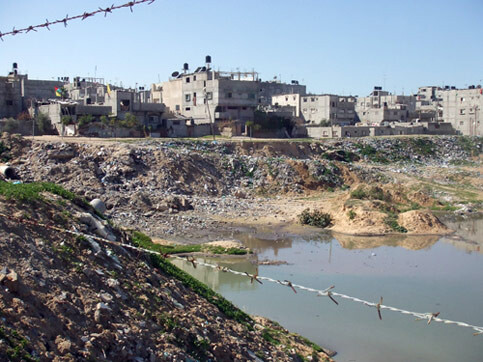The Electronic Intifada 3 March 2009

Sewage and pollution in the Khan Younis area of southern Gaza. (ICRC)
GAZA CITY (IRIN) - The lack of technical means to transport and process solid waste in Gaza is posing a severe risk to people’s health in the enclave, experts say.
Many Gazans, especially children, have developed breathing problems as a result of the stench emanating from rubbish dumps and the indiscriminate burning of waste; insects attracted to the rubbish tips and ground pollution pose further health risks, according to Bahaa Alagha, planning and project manager in Gaza’s Environment Quality Authority.
Solid waste is managed by three main entities: municipalities in the main cities; local councils in towns and villages; and the UN agency for Palestine refugees (UNRWA) in refugee camps. There are three official collection sites for solid waste — Rafah (south), Deir al-Balah (central), and Gaza City (the biggest).
Gaza Mayor Rafiq Mikki told IRIN the city’s 550,000 people produce 550-600 metric tons of solid waste a day, but that the enclave lacked the means to transport the waste to the main waste station near the Gaza-Israeli border for processing.
Mayor Mikki says the municipality does not have the capacity to solve the problem and has appealed for help from international organizations.
“Putrid smell”
“I and my family are suffering because of the bad smell from the nearby solid waste collection station,” said Layla Abu Aiesha, a resident of al-Yarmouk.
“We cannot stand the putrid smell. I feel ashamed when I have guests in my house. I am also concerned about my four kids. They always complain and say they cannot play in our garden because of the bad smell.”
“Many kinds of insect are around us because of the waste and this makes the place hard to live in, even in winter,” she said.
According to Hatem Moghani, public relations officer at the UK-registered charity the Qattan Foundation, which has offices opposite the al-Yarmouk dump, the worst stench occurs when the waste is collected by municipal workers prior to incineration. “This fouls the atmosphere. You cannot even breathe,” Moghani said.
Animal carts
Gaza Municipality has 55 registered vehicles for waste management but only 35 work — and they are old and in need of constant repair. “We are forced to transfer solid waste by animal cart,” said Mikki.
In parts of Gaza City, a house-to-house collection service is provided using donkey carts which take the waste to skips.
“The solution is to increase the number of vehicles used for transferring the waste directly to the main site,” said Abdelraheem Abulkumboz, who heads the municipality’s health and environment department.
Gaza’s main refuse dump receives 1,000 metric tons of solid waste a day — 600 mt from Gaza City, and 400 metric tons from other areas including the Beach and Jabaliya refugee camps.
The solid waste comes from households, building sites, agricultural processing plants, industry (including garages), and medical centers, according to a report by the Gaza health ministry.
This item comes to you via IRIN, a UN humanitarian news and information service, but may not necessarily reflect the views of the United Nations or its agencies. All IRIN material may be reposted or reprinted free-of-charge; refer to the copyright page for conditions of use. IRIN is a project of the UN Office for the Coordination of Humanitarian Affairs.


